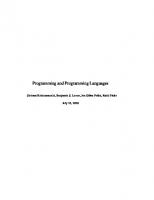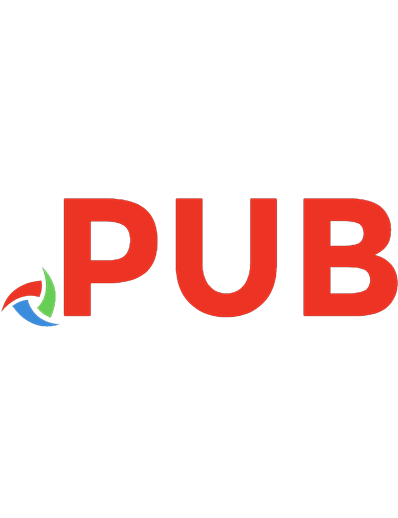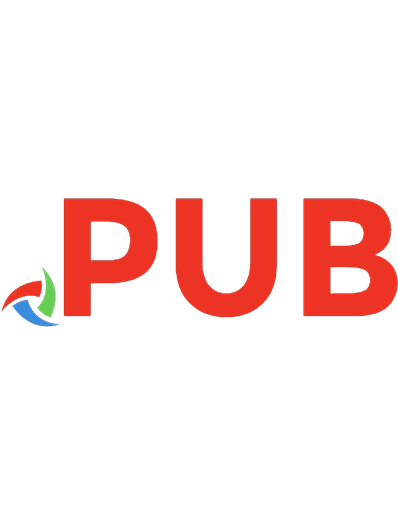Understanding Programming Languages 9783030592561, 9783030592578
This book is about describing the meaning of programming languages. The author teaches the skill of writing semantic des
859 157 2MB
English Pages 229 Year 2020
Table of contents :
Preface
Using this book
Writing style
Acknowledgements
Contents
Chapter 1 Programming languages and their description
1.1 Digital computers and programming languages
1.2 The importance of HLLs
1.3 Translators, etc.
1.4 Insights from natural languages
1.5 Approaches to describing semantics
1.6 A meta-language
1.7 Further material
1.7.1 Further reading
1.7.2 Classes of languages
1.7.3 Logic of Partial Functions
Chapter 2 Delimiting a language
2.1 Concrete syntax
2.2 Abstract syntax
2.3 Further material
Projects
Further reading
Historical notes
Chapter 3 Operational semantics
3.1 Operational semantics
3.2 Structural Operational Semantics
3.2.1 Relations
3.2.2 Inference rules
3.2.3 Non-deterministic iteration
3.3 Further material
Projects
Alternatives
Further reading
Historical notes
Chapter 4 Constraining types
4.1 Static vs. dynamic error detection
4.2 Context conditions
4.3 Semantic objects
4.3.1 Input/output
4.3.2 Arrays
4.3.3 Records
4.4 Further material
Projects
Further reading
Chapter 5 Block structure
5.1 Blocks
5.2 Abstract locations
5.3 Procedures
5.4 Parameter passing
5.4.1 Passing “by reference”
5.4.2 Passing “by value”
5.5 Further material
Projects
Further reading
Chapter 6 Further issues in sequential languages
6.1 Own variables
6.2 Objects and methods
6.3 Pascal variant records
6.4 Heap variables
6.5 Functions
6.5.1 Marking the return value
6.5.2 Side effects
6.5.3 Recursion
6.5.4 Passing functions as parameters [*]
Procedure variables/results
6.6 Further material
Projects
Chapter 7 Other semantic approaches
7.1 Denotational semantics
7.2 Further material
7.3 The axiomatic approach
7.3.1 Assertions on states
7.3.2 Hoare’s axioms
7.3.3 Specification as statements
7.3.4 Formal development
7.3.5 Data abstraction and reification
7.4 Further material
7.5 Roles for semantic approaches
Chapter 8 Shared-variable concurrency
8.1 Interference
8.2 Small-step semantics
8.3 Granularity
8.4 Rely/Guarantee reasoning [*]
8.5 Concurrent Separation Logic [*]
8.6 Further material
Projects
Further reading
Chapter 9 Concurrent OOLs
9.1 Objects for concurrency
9.1.1 An example program
9.1.2 Semantic objects
9.2 Expressions
9.3 Simple statements
9.4 Creating objects
9.5 Method activation and synchronisation
9.5.1 Method activation
9.5.2 Method synchronisation
9.5.3 Delegation
9.6 Reviewing COOL
The example class
COOL summary
9.7 Further material
Chapter 10 Exceptional ordering [*]
10.1 Abnormal exit model
10.2 Continuations
10.3 Relating the approaches
10.4 Further material
Projects
Historical notes
Chapter 11 Conclusions
11.1 Review of challenges
11.2 Capabilities of formal description methods
11.3 Envoi
Appendix A Simple language
A.1 Concrete syntax
A.1.1 Dijkstra style
A.1.2 Java-style statement syntax
A.2 Abstract syntax
A.3 Semantics
Statements
Expressions
Appendix B Typed language
B.1 Abstract syntax
B.2 Context conditions
B.3 Semantics
Appendix C Blocks language
C.1 Auxiliary objects
Objects needed for context conditions
Semantic objects
C.2 Programs
C.3 Statements
C.4 Simple statements Assignment
C.5 Compound statements
C.6 Blocks
C.7 Call statements
C.8 Expressions
Appendix D COOL
Abbreviations
D.1 Auxiliary objects
Types for context conditions
Types for semantics
D.2 Expressions
D.3 Statements
D.3.1 Assignments
D.3.2 If statements
D.4 Methods
D.4.1 Activate method
D.4.2 Call method
D.4.3 Rendezvous
D.4.4 Method termination
D.4.5 Delegation
D.5 Classes
D.5.1 Creating objects
D.5.2 Discarding references
D.6 Programs
Appendix E VDM notation
E.1 Logical operators
E.2 Set notation
E.3 List (sequence) notation
E.4 Map notation
E.5 Record notation
E.6 Function notation
Appendix F Notes on influential people
References
Index

![Understanding Programming Languages [1 ed.]
9783030592561, 9783030592578](https://dokumen.pub/img/200x200/understanding-programming-languages-1nbsped-9783030592561-9783030592578.jpg)








